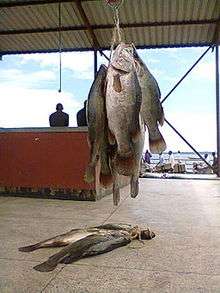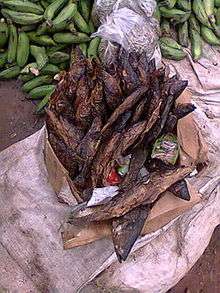Types of fish in Uganda
There are two major sources of fish in Uganda; one is from aquaculture, the other from fishing in rivers and lakes.[1] Different types of fish flourish in different water sources. The waters of Uganda contain an impressive array of fish species—over 90 in all. This count does not include the Haplochromis complex, which itself is made up of more than 200 species. Fish that are the target of most commercial and subsistence exploitation include species of Lates (Nile perch), Oreochromis (Nile tilapia), the herring-like Alestes, the catfishes Bagrus and Clarias, Hydrocynus (Tiger fish), the small pelagic “sardine” Rastrineobola, Protopterus (lungfish), and the haplochromines.[2]
Tilapia and Nile perch are the commonest types of fish in Uganda. Other fish types include tilapia, spat, cat fish, Nile tilapia, silver fish.[3]
Nile perch

The Nile perch (Lates niloticus) is locally known as "Empuuta", especially in the central region. It is a native species to Lake Albert, the River Nile below Murchison Falls, Lake Turkana, the Chad basin and rivers of West Africa. It was introduced into Lakes Kyoga and Victoria basins in the mid-1950s but its presence in Lake Victoria was first noted in 1960. Although Lates was introduced into Lake Victoria in the early 1960s it took more than 10 years to get fully established in the new ecosystem.[4] They weigh up to 80 kilograms.
Tilapia


It is locally known as "Engege". It is among the oldest types of fish in Uganda.[4]
Nile tilapia
Nile tilapia (Oreochromis niloticus) are native species to Lake Albert, the River Nile below Murchison Falls, Lake Turkana, the Chad basin and rivers of West Africa (Lowe-McConnell, 1988).[4]
Catfish
Catfish is locally known as "Semutundu" and Bagrus Catfish, Bagrus docmak (scientific name).[5] It is grey-black above, creamy white below. It lives in both shallow and deep water. It feeds on insects, crustaceans, mollusks and fish. Takes any live or dead bait fished on or near the bottom.[6]
Silver fish
It is locally known as "Mukene" [7]
Lungfish
It is locally known as "Emamba"
Eels
Eels are locally known as "Ensonzi". They are caught from swamps. Once caught, they are wound on sticks and then dried. They are mostly put in ground nut soup to add a flavour of fish.
Sprat
Sprat is locally known as "Enkejje" in the central region. It is fished near the shore. It is dried and sold in markets on sticks. It is usually fried and eaten as source but mostly prepared in groundnut soup.
Clarias
Clarias is locally known as "Emalle". It is in the cat fish family.
Tiger Fish (Small)
It is locally known as Ngassa. Scientifically, it is called Hydrocynus forskahlii. It is an open water predator often found near the surface and in fast flowing water. It Forms shoals and feeds on fishes, preferring long bodied fish, as they are easier to swallow. Also takes insects, grasshoppers and snails. Cannibalistic. Silver with long and slender profile. Tail fin forked with bright red color, rest of fins uniformly grey. Regularly takes spinners retrieved a high speed across fast-flowing water. It is used by fishermen as live bait for Nile Perch.[6]
Tiger Fish
Tiger fish is locally known as Wagassa, and scientifically as Hydrocynus vittatus. It grows up to 105 cm long and 28 kg in weight. It has long gill rakers. The tips of adipose and dorsal fins black. The forked edge of its tail fin is black. It prefers warm, well-oxygenated water in larger rivers and lakes. All but the largest fish form roving schools of like-sized fish; aptly described as fierce and voracious. It feeds on whatever prey is most abundant.[6]
Barbel
It is also known as Golden Barbel, and scientifically as Barbus byyni byyni. It grows up to 82 cm in length and 4 kg in weight. It is confined to the Nile and lakes that were once connected to the Nile. It feeds on crustaceans, insects, mollusks and organic debris.[6]
Upside-down catfish/ Wahrindi
It is commonly known as squeaker, and scientifically as Synodontis Victoriae. It grows up to 35 cm in length and 1.5 kg in weight. It has one strong dorsal spine and spines within the pectoral fins, which are long and serrated. The spines can be locked at right angles to the body as a form of self-defence. It squeaks when caught or distressed. It is found mostly near soft bottoms of the water bodies and close to banks. Near waterfalls, it is found in slower flowing water. The fish of the shallow, faster water are generally of a lighter greyish-green colour, whilst the fish of the deeps are a darker, blacker colour.[6]
Silversides/Alestes Baremoze
It is locally known as Ngara, and scientifically as Alestes Baremoze Baremoze. It grows up to 43 cm in length, and 500 g in weight. It is silver coloured with blue-grey black and white belly, greyish fins with orange colours on the lower lobe of the tail fin. It is caught withspinners, spoons and fly. It also takes float fished dough and termites.[6]
Electric Catfish
Its scientific name is Malapterurus Electicus. It grows up to 1 metre in length and 20 kg in weight. It lives in rocky waters or roots and favours sluggish or standing water. It is most active at night, feeding mainly on fish stunned by electric shocks. The electric organ, capable of discharging 300-400 volts, is derived from pectoral muscle and surrounds almost the entire body. It is used both for prey capture and defense. Forms pairs and breeds in excavated cavities or holes.[6]
See also
References
- ↑ "2013 STATISTICAL ABSTRACT" ubos.org.Retrieved on October 29, 2014.
- ↑ "REVIEW OF FISH MARKETING IN UGANDA" fao.org.Retrieved on October 30, 2014.
- ↑ "List of Freshwater Fishes for Uganda" fish.mongabay.com.Retrieved on October 29, 2014.
- 1 2 3 "FISHERY RESOURCE BASE FOR THE UGANDA SECTOR OF LAKE VICTORIA" fao.org. Retrieved December 12, 2014
- ↑ "Semutundu is the snake-like fish that many find a delicacy" monitor.co.ug. Retrieved November 12, 2014
- 1 2 3 4 5 6 7 "Fish to be caught" fishingmurchison.com.Retrieved December 12, 2014
- ↑ "Uganda's Mukene Harvest the Lowest in East Africa" ugandaradionetwork.com. Retrieved November 14, 2014